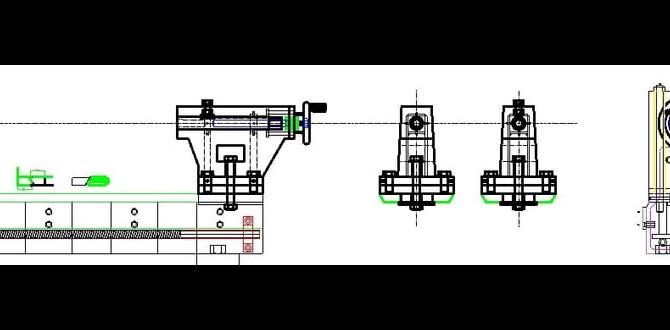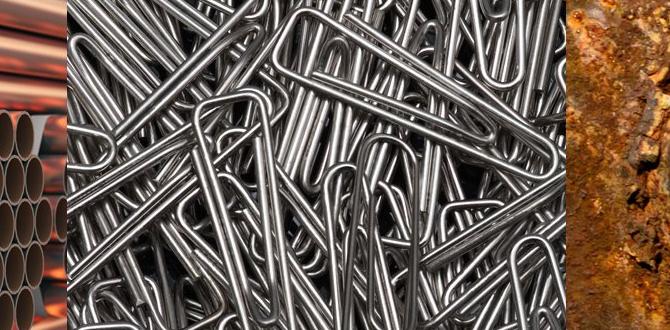The Tialn ball nose end mill with a 35-degree helix angle is your go-to tool for efficiently and accurately profiling hardened steel up to HRC60. Its specialized coating and geometry reduce heat, prevent chipping, and ensure a smooth finish, making complex hardened steel cuts achievable for beginners.
Working with hardened steel can feel like a daunting task, especially when you’re just starting out. It’s tough, unforgiving, and can quickly chew up the wrong tooling. If you’ve ever struggled to get a clean profile on materials like tool steel or hardened shafts, you know the frustration. But what if I told you there’s a specific tool designed to make this easier? That’s where the Tialn ball nose end mill with a 35-degree helix angle shines. It’s a game-changer for profiling hardened materials, and today, we’re going to break down exactly why it’s so essential and how you can use it confidently.
Understanding the Tialn Ball Nose End Mill 35 Degree
Let’s start by getting to know our star player: the Tialn ball nose end mill with a 35-degree helix angle. It might sound technical, but it perfectly addresses the challenges of cutting hardened steel. Think of it as a specialized tool built for a tough job.
What Makes It Special?
Several key features contribute to the effectiveness of this specific end mill:
- Ball Nose Geometry: Unlike flat-bottomed end mills, a ball nose has a rounded tip. This is crucial for profiling because it allows for smooth, continuous cuts without creating sharp corners or undercuts, which can be stress points. It’s also excellent for creating radiused features and contours.
- 35-Degree Helix Angle: The helix angle refers to the spiral of the cutting flutes. A 35-degree angle is a bit of a sweet spot for hardened steels. Lower angles can sometimes lead to excessive heat and chatter, while very high angles might not provide enough clearance. The 35-degree angle offers a good balance of chip evacuation, reduced cutting forces, and vibration dampening. This means a smoother cut and less wear on your machine and the tool.
- Tialn Coating: This is a big one for hardened steel. Tialn, or Titanium Aluminum Nitride, is a super-hard coating applied to the end mill. It provides:
- Extreme Hardness: It’s significantly harder than the steel you’re cutting.
- High Heat Resistance: Machining hardened steel generates a lot of heat. The Tialn coating acts as a thermal barrier, preventing the cutting edge from softening and extending tool life dramatically.
- Reduced Friction: It creates a smoother surface, allowing chips to flow away more easily and reducing the tendency for the tool to weld to the workpiece.
- Material Specific Design: These end mills are often made from high-performance materials like solid carbide, which further enhances their strength and ability to handle tougher environments without breaking or dulling quickly.
Why 35 Degrees for Hardened Steel (HRC60)?
Hardened steel, especially materials hardened to HRC60 (which is quite hard!), presents unique machining challenges. Standard end mills can quickly overheat, chip, or break. Here’s why the 35-degree helix angle is particularly beneficial:
- Optimal Chip Evacuation: When milling, chips need to be cleared away from the cutting zone quickly. The 35-degree helix angle helps lift and eject chips efficiently. In harder materials, this is critical to prevent chip recutting, which leads to tool breakage and poor surface finish.
- Reduced Cutting Forces: A well-designed helix angle distributes the cutting load more evenly. This results in lower forces acting on the tool and the workpiece, reducing the risk of chatter and improving overall stability.
- Heat Dissipation: While the Tialn coating is the primary defense against heat, the helix angle also plays a role. It affects how the cutting edge engages the material and how heat is generated and carried away with the chips. The 35-degree angle is a good compromise for managing heat in tough materials.
- Vibration Dampening: Hardened steels can be prone to vibration, which is the enemy of a good finish and tool life. The 35-degree helix angle often contributes to a more stable, dampened cut compared to steeper or shallower angles, leading to a smoother surface.
When you combine the ball nose shape, the effective Tialn coating, and this specific 35-degree helix angle, you get a tool that’s purpose-built for tackling materials that would otherwise be incredibly difficult to machine. It’s not just a general-purpose end mill; it’s a specialist for hardened steel profiling.
When to Choose a Tialn Ball Nose End Mill 35 Degree
Knowing when to deploy this specialized tool is key to success. It’s not your everyday end mill, so understanding its niche will save you time, frustration, and potentially prevent tool breakage.
Ideal Applications
You’ll want to reach for your Tialn ball nose end mill (35-degree helix) in scenarios like these:
- Profiling Hardened Steels: This is its primary role. If you need to cut shapes or contours into materials like D2, A2, M2, or other tool steels that have been hardened to around HRC55-HRC60, this is your tool.
- Creating Radiused Pockets: Need to mill a cavity with a rounded bottom or internal corners? The ball nose shape is perfect for this.
- Finishing Operations: For achieving a smooth, accurate surface finish on complex 3D geometries in hardened materials.
- Engraving and Detail Work: The precise nature of ball nose mills makes them suitable for detailed work where smooth transitions are essential.
- Mold and Die Making: Machining intricate details, cavity shapes, and draft angles in hardened tool steels used for molds and dies.
- Aerospace and Medical Components: Many high-performance parts in these industries require precision machining of hardened alloys.
When to Consider Alternatives (Or Be Extra Cautious)
While this end mill is excellent, it’s not a universal solution:
- Soft Materials: For soft aluminum, mild steel, or plastics, a standard carbide or even high-speed steel (HSS) end mill will likely be more cost-effective and perform just as well. The Tialn coating and specialized geometry are overkill for softer metals.
- Very Deep Slotting: Ball nose end mills are not ideal for cutting deep, narrow slots unless the slot itself has a radiused bottom. For square-bottomed slots, a standard square end mill designed for the material is better.
- Roughing Operations: While it can do roughing, its primary advantage is in profiling and finishing. For bulk material removal, especially in less demanding materials, dedicated roughing end mills with high-efficiency chip breaker features might be faster.
- Extremely High-Speed Machining of Soft Materials: For very high-RPM aluminum machining, specialized aluminum end mills are often preferred for their chip control and void-free surfaces.
In essence, if your task involves cutting into hardened steel (up to HRC60) and requires smooth contours, radiused features, or a high-quality surface finish, the Tialn 35-degree ball nose end mill is likely an excellent choice. It’s designed to handle the heat and toughness that would defeat less specialized tooling.
Essential Setup and Machining Parameters
Using the right tool is only half the battle. Setting up your machine and choosing the correct cutting parameters are crucial for achieving good results and ensuring tool longevity. Machined steel to HRC60 hardness requires a disciplined approach to machining.
Machine Rigidity is Key
Hardened steel is unforgiving of flex and vibration. Before you even think about speeds and feeds, ensure your machine is up to the task:
- Sturdy Machine Tool: A solid, well-maintained milling machine is essential. Light-duty hobby machines may struggle with the forces involved.
- Tight Spindle Bearings: Any play in the spindle will translate into poor surface finish and premature tool wear.
- Secure Workholding: The workpiece must be held incredibly firmly. Use high-quality vises, clamps, or fixture plates. Ensure there’s no movement during the cut.
- Rigid Tool Holder: Use a high-quality, runout-free tool holder, preferably a shrink-fit or high-precision collet chuck. Avoid set-screw holders for this type of work.
Speeds and Feeds – General Guidelines
This is where it gets tricky, as exact speeds and feeds depend on many factors: the specific alloy of the hardened steel, the machine’s capabilities, the coolant being used, the depth of cut, and the exact dimensions of your end mill. However, here are some fundamental principles and starting points:
Surface Speed (SFM or SMM)
For carbide end mills with Tialn coatings in hardened steel, you’ll generally start with lower surface speeds than you would for softer materials.
- Starting Range: 100-250 SFM (Surface Feet per Minute) or 30-75 SMM (Surface Meters per Minute).
- Adjustments: If tool wear is fast, lower the speed. If you’re getting a good finish and the tool seems to be holding up, you might be able to increase it slightly.
Chip Load (IPM/tooth or MMP/tooth]
Chip load is the thickness of the material removed by each cutting edge per revolution. This is CRITICAL for tool life and finish in hardened steel.
- Rule of Thumb: A good starting point for a 35-degree helix Tialn ball nose end mill in HRC60 steel might be around 0.0005″ – 0.0015″ (0.013 mm – 0.038 mm) per tooth. This will depend heavily on the diameter of the end mill. Smaller diameters require significantly smaller chip loads.
- Why it Matters: Too small a chip load leads to rubbing, excessive heat, and premature wear (often referred to as “work hardening” the surface). Too large a chip load can overload the cutting edge, leading to chipping or breakage.
Rotational Speed (RPM)
This is calculated using the Surface Speed and the tool diameter:
RPM = (Surface Speed (SFM) 12) / (π Diameter (inches)) or RPM = (Surface Speed (SMM) 1000) / (π Diameter (mm))
Example: For a 1/4″ (0.25″) diameter end mill at 150 SFM:
RPM = (150 12) / (3.14159 0.25) = 2292 RPM (approx.)
Axial Depth of Cut (DOC)
How deep you cut into the material along the Z-axis.
- Roughing: For profiling, you might take a significant portion of the radius as DOC, perhaps 25-50% of the radius, but with conservative chip load.
- Finishing: For a final pass, a very shallow DOC (e.g., 0.010″ – 0.020″ or 0.25mm – 0.5mm) is common to achieve a high-quality surface finish.
Radial Depth of Cut (Stepover)
How much the tool moves sideways with each pass. For profiling, this is often controlled by cutter diameter and desired finish.
- Roughing: Can be up to 50% of the tool diameter.
- Finishing: For a smooth surface, stepovers from 10% to 30% of the tool diameter are common. For very fine finishes, smaller stepovers are used. Some software can calculate “scallop height” which directly relates to stepover and finish quality.
Coolant and Lubrication
Machining hardened steel generates significant heat, and proper cooling is non-negotiable. It:
- Cools the cutting edge, preventing thermal damage.
- Flushes chips away from the cutting zone.
- Lubricates the cut, reducing friction.
Recommended Coolants:
- Flood Coolant: A high-pressure coolant system delivering a large volume of fluid is ideal.
- Mists/Aerosols: For smaller machines or specific applications, coolant mist systems can be effective.
- Lubricating Oils: In some cases, a specific heavy-duty cutting oil can be applied.
Always use a coolant specifically designed for high-hardness steels and carbide tooling. Check your machining supplier’s recommendations.
Example: Profiling a Hardened Steel Part
Let’s say you have a 1/2″ diameter Tialn 35-degree ball nose end mill and you need to profile the outer shape of a hardened tool steel part (HRC60).
Assumptions:
- Machine: Rigid vertical milling machine.
- Workholding: Robust vise.
- Coolant: Flood coolant.
- Target Material: AISI D2 Tool Steel, HRC60.
Calculations & Parameters:
1. Speeds & Feeds Table (Example – always verify and adjust!)
| Parameter | Value (Approx. for 1/2″ dia. end mill) | Notes |
|---|---|---|
| Surface Speed (SFM) | 150 SFM | Start conservatively. |
| RPM | (150 12) / (3.14159 0.5) = 1146 RPM | Target spindle speed. |
| Chip Load per Tooth (CL) | 0.0010″ – 0.0015″ | Depends on tool quality and machine rigidity. |
| Number of Flutes (Z) | 4 (typical for carbide) | Verify your tool. |
| Feed Rate (F) | RPM Z CL = 1146 4 0.00125″ (mid-range) = 5.73 IPM | Target feed rate. |
| Axial Depth of Cut (DOC) | 0.050″ – 0.100″ | For roughing passes. |
| Radial Depth of Cut (Stepover) | 0.100″ – 0.200″ (20-40% of tool dia.) | Adjust for finish quality. |
| Finishing Pass DOC | 0.005″ – 0.010″ | For final surface finish. |
| Finishing Pass Stepover | 0.050″ (10% of tool dia.) | For smooth finish. |
2. Programing the Toolpath:
Use your CAM software to define the profiling toolpath. Ensure it engages the material correctly, maintaining a consistent chip load. For profiling, you’ll typically use contour milling operations. For 3D features, 3D contouring or pocketing strategies might be employed.
3. On-Machine Verification:
- Run the program in single-block mode, watching every movement.
- Use a coolant nozzle to ensure coolant is directed exactly where the tool engages the material.
- Listen for any unusual noises (chatter, grinding) and be ready to stop the machine.
- After the first few cuts, inspect the tool for signs of wear or chipping. Check the surface finish of the workpiece.
Important Note: These numbers are starting points. Always consult the end mill manufacturer’s recommendations if available. If you are unsure, start with extremely conservative parameters and incrementally increase them while monitoring tool performance and workpiece finish.
Step-by-Step Guide to Profiling Hardened Steel
Let’s walk through the process of using your Tialn 35-degree ball nose end mill to profile a hardened steel part. We’ll keep it straightforward, focusing on the essential steps.</






